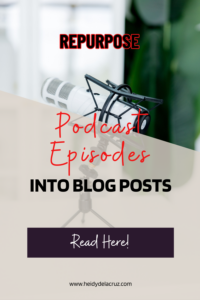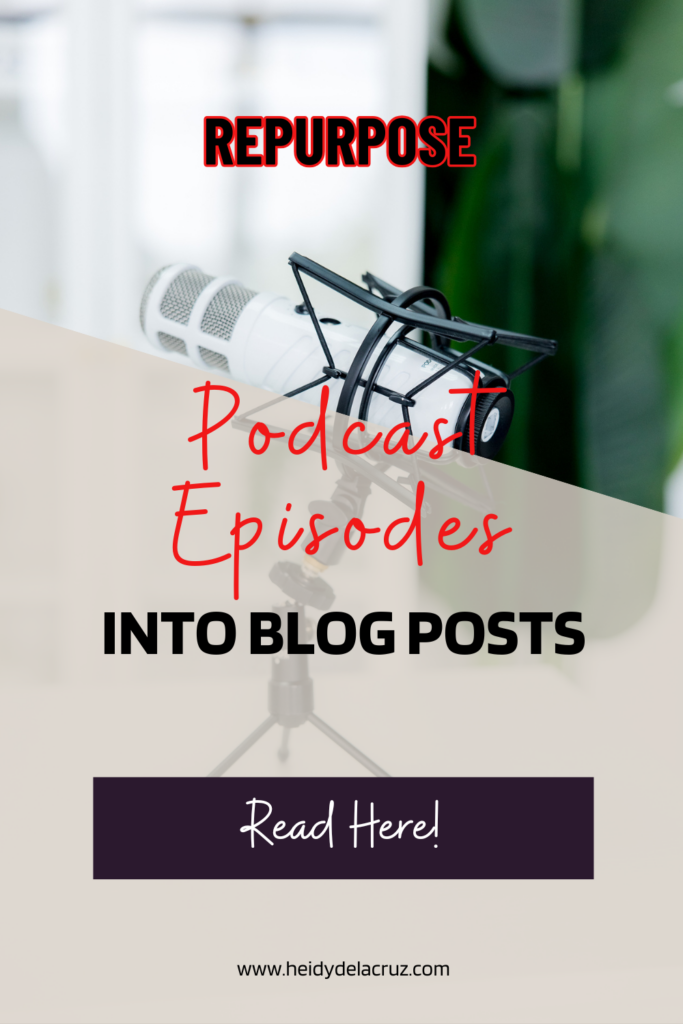One of the things I wish I had done when I started my podcast is repurpose each episode into a blog post. However, in the first year of podcasting, my focus was on finding guests to maintain consistency in publishing content and getting the hang of producing a podcast.
It wasn’t until about a year and a half or closer to two years that I started turning each episode into blog posts. At this point in my podcasting journey, I felt more comfortable as a producer and host. I established my systems for the podcast cycle and was able to add another element to my marketing strategy: blog posts.
Converting your podcast episodes into blog posts is one of the most effective ways to increase visibility (and engagement!) for your show. Not only does it help you repurpose valuable information, but it also boosts your podcast’s visibility through search engine optimization (SEO). As a podcaster who’s focused on growth, I’ve developed a simple system to turning each episode into blog posts.
Lastly, I needed to get my website together, too, before I could start adding content there. Luckily, everything came together, although I will admit that it was a little stressful at the beginning. Here’s how I repurpose a podcast episode into a blog post.
This post contains product affiliate links. I may receive a commission if you purchase after clicking on one of these links at no extra cost to you.
Use the Episode Transcript to Find Three Main Points of the Episode
This can get a little tricky for the podcast I produce because my guests share their immigration stories. And I usually stay around the same themes for each guest. I usually ask them about their life before they moved, the culture shocks they experienced once they moved, and what they are up to today.
So, finding three main points that are not the same for every guest was challenging at first. I would read the transcript that Apple Podcasts produced after the episode was published to find my main points.
Now, I use WhisperTranscribe to generate the transcript in a Word document before publishing the episode, and then I upload the transcript to ChatGPT. I ask ChatGPT to help me identify the three main points and outline them in a blog post. An outline is better than telling AI to write the blog for you because you want the post to be in your words. Google will know if AI or a human wrote the content.
Each point will be a paragraph, so because I highlight three, that’s the three middle paragraphs of the blog post. And then I’ll have the introduction paragraph and the conclusion, which also has the link to watch the episode on YouTube.
Format the Blog Post for SEO
After writing everything, I ensure the blog post is formatted correctly for SEO. As mentioned above, I make sure I have a minimum of five paragraphs. Some posts may have more, but I need an introduction paragraph, three paragraphs that highlight the main points, and a conclusion.
I select my keyword and ensure it’s included in the title of the blog post, some of the headers, and is sprinkled throughout the blog post.
Each blog post has a graphic. I use the same graphic as the podcast episode; the only difference is that I include a quote from the guest. Usually, the quote is what the American Dream means to the guest. Unless the guest says something else that’s really deep, I keep it on brand about what their American Dream means because that’s what the whole podcast is about.
I mention using the same graphic for the episode because there is no need to create new content every time you market your show. You can always repurpose content. That is working smarter and not harder.
In another post, I shared three different ways you can repurpose your podcast content.
Use Missinglettr and Pinterest to Promote the Blog Post
Once the blog post is in the correct format, editing is complete, and it has been published, it’s time to promote. This is where MissingLettr and Pinterest come in.
In a previous post, I shared how I use MissingLettr to promote each blog post for a year. For Pinterest, I ensure that I create five pins per post.
I like to mix in new blog posts with older ones when creating pins for Pinterest, so each blog post gets promoted multiple times.
Conclusion on Repurposing Podcast Episodes Into Blog Posts
Repurposing podcast episodes into blog posts is not only a time-saver—it’s a smart strategy to grow your audience across platforms. If you’ve been wondering how to extend your podcast content, try this method. With a transcript, a few takeaways, and the right tools, you can turn each episode into a blog post that keeps delivering value all year long and years to come.
Bonus tip: If you mainly share solo episodes on your podcast, rather than interviews like me, use your episode outline to create a blog post. The method I just shared is even easier for solo episodes. Don’t have an episode outline? I have a podcasting starting kit that includes one.
With Love, Heidy
Check out my SEO Guide and Free Podcasting Resources at – https://stan.store/heidydelacruz
Sign up for my newsletter to join the podcasting community and receive the latest tips and insights!
Other Posts You May Enjoy:



